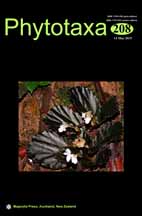Abstract
The terete taxa Gracilariopsis (hereafter Gp.) lemaneiformis (Bory) Dawson, Acleto & Foldvik and Gracilaria (hereafter G.) chilensis Bird, McLachlan & Oliveira resemble each other in branching pattern. This study aims to analyze samples attributed to G. chilensis from a southern locality in Peru using molecular tools, in order to differentiate it from Gp. lemaneiformis samples collected along the Peruvian coast. Species identification of the Gracilariaceae, especially of the terete forms, is notoriously difficult due to morphological plasticity and convergence of their thalli, and the correct taxonomic identification of non-reproductive, cylindrical specimens remains a difficult task (Gurgel & Fredericq 2004). Utilizing traditional morphometric techniques, Edding et al. (2006) concluded that G. chilensis, comprising a single morphotype, is the main species of Gracilaria present along the Chilean coast, in which natural populations are distributed between 30°S and 45°S, from Coquimbo to Southern Chiloe (Bird et al. 1986), with farms extending further north to Antofagasta (24°S) (Santelices & Ugarte 1990). Hoffmann & Santelices (1997) found the establishment of G. chilensis on the coast of Coihaique (45°S) mainly due to aquaculture introduction. This species also occurs in the western Pacific Ocean, ranging from southeastern Australia to New Zealand (Nelson 1987). Gracilariopsis Dawson was long merged into Gracilaria until Fredericq & Hommersand (1989) resurrected Gracilariopsis on the basis of lack of nutritive cells in the cystocarp, and with chorda-type surface spermatangia. Gp. lemaneiformis has a geographical range from Paita, Peru to Antofagasta in northern Chile (Ramírez & Tapia 1991). DNA sequence analysis has been the most reliable and widely used molecular technique to infer phylogenic relationships at the species level within the Gracilariaceae (Gurgel & Fredericq 2004), and recognition of Gracilariopsis as a genus distinct from Gracilaria received strong support from the molecular studies of Bird et al. (1994), and Gurgel et al. (2003), among others. According to Gurgel et al. (2003), Gp. lemaneiformis is shown not to have a worldwide distribution but to be restricted to the vicinity of Peru, whereas the species going under the name Gp. “lemaneiformis” from North and South Carolina is now referred to as Gp. carolinensis Liao et Hommersand, and Gp. “lemaneiformis” from China and Japan constitutes an undescribed species that is related to Gp. heteroclada Zhang et Xia.

